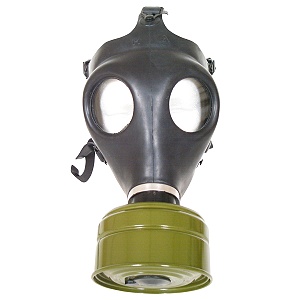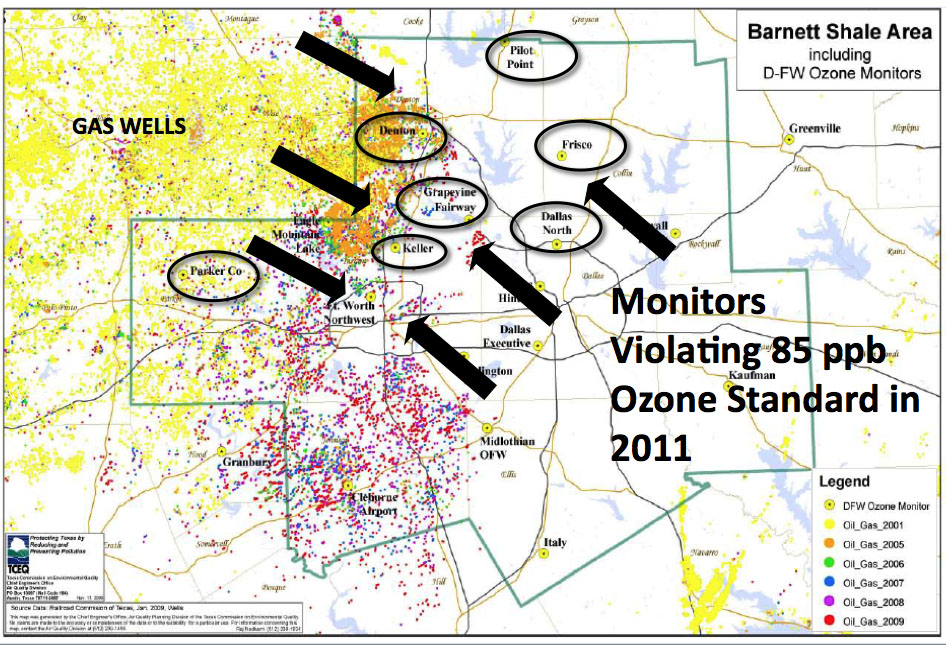DFW SIP
New Evidence of Ozone Health Harms in the Air You’re Breathing This Week
 As of 10 am on Tuesday, air quality monitors in Grapevine, Midlothian, Frisco and the Redbird area of Dallas had already recorded "Level Orange" concentrations of smog, including a 106 ppb reading in Grapevine. As late as 9 pm last night, ozone levels were still in the 90's in Weatherford. It's going to be another long, hot day of bad air throughout the DFW area. Which means they'll be people suffering form breathing that bad air. Today there's new evidence that that suffering includes heart attacks and strokes caused directly by ozone pollution.
As of 10 am on Tuesday, air quality monitors in Grapevine, Midlothian, Frisco and the Redbird area of Dallas had already recorded "Level Orange" concentrations of smog, including a 106 ppb reading in Grapevine. As late as 9 pm last night, ozone levels were still in the 90's in Weatherford. It's going to be another long, hot day of bad air throughout the DFW area. Which means they'll be people suffering form breathing that bad air. Today there's new evidence that that suffering includes heart attacks and strokes caused directly by ozone pollution.
EPA Toxicologists at Research Triangle, North Carolina exposed willing subjects to clean air, or to air containing 0.3 parts per million ozone. On the high-ozone day, volunteers inhaled the same cumulative dose that they would have received over eight hours in a place that exceeded the U.S. federal limit of 75 parts per billion for that length of time. Just like we've been doing here in DFW for the past three days. The results of the study showed ozone is causing acute — and even chronic — risk for heart attacks in the people who breathe it.
Blood levels of inflammatory agents increased, sometimes even doubling, after the subject's ozone exposure, and this increase could last more than a day. High ozone exposure also triggered subtle changes in heart rate variability, indicating a higher risk of arrhythmias. Ozone also altered levels of several proteins involved in blood clotting.
A decade ago the head of the Texas environmental agency stated that Ozone was a "benign pollutant" and argued against lowering the national standard for exposure to it. Last year, Texas state government again fought a lowering of the ozone standard, saying there was no proof of harms at levels below 85 parts per billion despite an independent panel of scientists saying there was. The more we know about how ozone impacts the human body the more we see that even levels considered "safe" a few years ago have far-reaching harmful effects.
75, 85, 105 parts per billion. These are just numbers from monitors. Behind them are real people having asthma attacks, heart attacks, and strokes. This is why it's important to win the battle with DFW's chronic smog. This is why it's a public health issue that's too important to be left up to a group of political appointees in Austin beholden to industry that too often pretends there's not even a problem.
Halfway to Failure
 (Late Monday evening update: It's clear that the Hinton Street monitor will record its third "exceedence" of the 85 ppb standard this year, putting it just one away from making the entire region non-attainment" in 2012.)
(Late Monday evening update: It's clear that the Hinton Street monitor will record its third "exceedence" of the 85 ppb standard this year, putting it just one away from making the entire region non-attainment" in 2012.)
It's a bad sign when there are ozone problems on the weekends. It means that even with less people on the road and many businesses on less than full throttle, there's still enough pollution to cause trouble. And it usually means a rough week ahead. That's what happened on Sunday, when summer finally caught up with DFW in a big way.
Four area ozone monitors set new annual highs set on Sunday, and many others saw very alarming numbers during the afternoon. There were three "exceedences" of the old 1997 85 parts per billion ozone standard, and one of those was the second time the Dallas Hinton Street site had seen an 8-hour average above 85 this year. Six other monitors have already had their first. And it's only June.
Four such exceedences within a year puts a monitor in official violation of the obsolete standard that DFW is still struggling to meet. So with the Hinton Street results, we're already halfway to being out of compliance with the 1997 standard again. But it's all academic. Everything is now geared toward meeting the new 75 parts per billion ozone standard by 2018. DFW could be in violation of the old standard every year from now until then, and except for the terrible toll on public health, there'd be no penalty from either the EPA or TCEQ.
On the other hand, its going to be pretty hard to meet that new, harder standard when you haven't been meeting the old, easier one.
The state's official response is mostly to sit back and hope that DFW drivers trade in their older, more polluting cars for cleaner, newer ones. That phenomena was supposed to be responsible for making this year the best one for clean air in decades. According to the Texas Commission on Environmental Quality's computer modeling, no DFW monitor will violate the Clean Air Act for ozone pollution in 2012. At least, that's what they told the EPA when they submitted the region's clean air plan to the feds in December. And the EPA bought it. Because the TCEQ computer modeling said everything was hunky-dory.
But reality has a way of rudely intruding on TCEQ's computer modeling. Only six months into the new plan and most of the DFW monitor averages predicted by the state are already underestimates. We had the highest ozone levels ever recorded in March. Maybe there's just not enough of you trading in your cars.
 Or maybe it's just that old TCEQ junk science at work. One thing we know the state's computer model didn't consider was how already-dirty air makes the VOC pollution from natural gas operations more easily convert into ozone pollution. Denver officials who are also dealing with new gas operations contributing to long-standing smog problems have considered this factor and think it explains larger than expected ozone readings there.
Or maybe it's just that old TCEQ junk science at work. One thing we know the state's computer model didn't consider was how already-dirty air makes the VOC pollution from natural gas operations more easily convert into ozone pollution. Denver officials who are also dealing with new gas operations contributing to long-standing smog problems have considered this factor and think it explains larger than expected ozone readings there.
TCEQ chose to ignore this variable. Supposedly because the gas patch was well west of DFW and "couldn't possibly" affect North Texas ozone levels. But as anyone who's driven I-30 or I-20 over the past ten years can tell you, the gas patch extends all the way from east of Denton to Grand Prairie to Midlothian, encompassing most of the 9 county non-attainment area. In the same December 2011 clean air plan the state predicted record-low ozone levels this year, it also estimated that gas industry sources were emitting 34 tons per day more smog-forming VOC pollution than all the cars and trucks in DFW combined.
It was a political decision not to look at how dirty air from Houston, the East Texas coal plants, the Midlothian cement kilns and everything else east of Weatherford makes gas industry emissions more likely to cause ozone in North Texas. TCEQ's clean air plans are always full of such decisions that drive the final results of its supposedly objective computer modeling. Hard to believe now, but there was a time in the not-so-distant-past that the same computer modeling made it clear that the Midlothian cement plans "couldn't possibly" be affecting DFW ozone levels.
A plan to meet the new 75 ppb standard must be submitted to EPA by 2015 to show three years of compliance by 2018. That's only two-years away. If new cars alone can't get us down below 85, it will be extremely difficult for the state to argue they can get us down to 75. More actual things that work to reduce pollution will be necessary. Including bringing better controls to the cement kilns and coal plants and other industries still putting out way too much pollution. It will be a fight. but so far, the evidence is that more is needed if DFW is ever going to have safe and legal air.
More Details on the New DFW Smog Boundaries and Timeline
First, if you haven't read our updated post below, please notice the correction to Tuesday's initial story. DFW's "Moderate" classification by EPA under the new 75 ppb ozone/smog standard is actually a more serious ranking than Houston's "Marginal" ranking. In fact, areas with Marginal status are expected to be able to achieve the standard without even having to submit a clean-up plan with special pollution control measures. That's right, for the first time in forever, Houston won't even have to submit a "SIP" – State implementation Plan – while DFW will have to write yet another one, the fourth one in 15 years. According to EPA's announcement, most metropolitan areas were classified as "Marginal," identifying North Texas right off the bat as one of the more seriously smoggy places in America (but still way behind parts of California with an "Extreme" label slapped on the LA basin, and "Severe" for three more separate areas.) Most of DFW's sunbelt peers have fared better than our metormess. Atlanta started out at the same place as DFW 15-20 years ago, but has cleaned up its act enough to rate a "Marginal" in this round. Phoenix is also "Marginal." But of course neither one of those has a major natural gas play in the middle of them. Second, the timeline for the next DFW's next smog plan is known. The clock begins ticking 60 days after the new designations are published in the Federal Register – sometime between July and September of this year. From that date, DFW leaders and the Texas Commission on Environmental Quality have exactly three years – until the summer of 2015 – to design and build a new clean air plan for DFW that will meet the 75 ppb standard. We have a three year running average of 90.6 ppb. Not to worry however. TCEQ has already told us that ozone levels will drop to historic new lows this summer thanks to so many new cars being bought. On the outside chance that doesn't happen, the Rick Perry- driven TCEQ will have to find some other nonsensical rationalization for avoiding new controls on the Governor's industrial contributors – cement plants, the gas industry, and power plants, like they did last year with the new car strategy. But don't look for Austin to even start working on this clean air plan until 2014. There's no rush because the agency doesn't believe the 75 ppb standard is even necessary. The Commission's leadership was vocal in its opposition against it. If local leaders were smart, they'd disconnect their own clean air efforts from the state's and begin doing their own planning immediately, but traditionally they don't move until TCEQ says "jump". Add to this the new element of regional elected officials who, like Governor Perry, not only don't want to impose any new controls on industry, but don't even concede the value of cleaner air, and you already have a formula that's in danger of repeating last year's Worst Clean Air Plan Ever. 2015 isn't that far away, but without a serious overhaul of the regional air quality planning process, hope of meeting the new smog standard seems further than ever. By the way, counting our correction of the original story we ran on Tuesday, we've now published three posts on the new smog boundaries and deadlines. That's three more than any other source that we can find this morning.
